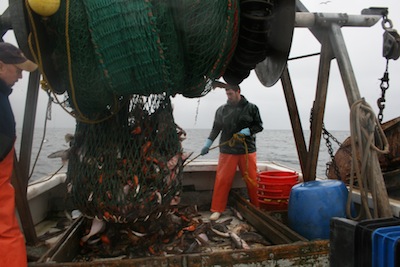Despite years of ever-increasing monitoring, cooperation from the fleet, and catch-shares-induced consolidation, the New England groundfish industry is still on shaky ground.
A Maine Fishermen's Forum presentation by Melissa Errend of the New England Fishery Management Council illustrated the council-considered options for monitoring the groundfish fleet (Amendment 23). This presentation focused on the effects on the Maine-based fleet, which is Portland-based.
With projected costs of each alternative ranging from about $1 million to more than $5 million across the fleet, the council expects the changes to force groundfish boats with the fewest at-sea days to lease out their quota rather than go fishing.
The council's preferred alternative is a blended model that allows boat owners to choose between traditional at-sea monitoring and electronic monitoring.
One Portland-based boat is using the experimental full-retention model that incorporates a combination of full-time cameras on the boat, landing all fish that would qualify as discards, and dockside monitoring and sampling of those retained discards.
However, the council has not announced any benefits resulting from the proposed (and expensive) changes to monitoring.
"Are we going to begin to get something back for that level of accountability?" asked Jackie Odell, executive director of the Northeast Seafood Coalition.
Several stakeholders suggested the possibility of opening some closed areas as monitoring increases.
"I'm not sure improved monitoring removes the need for protection in those areas," said Tom Nies, the council's executive director. He added that the purpose of the closed areas is not to reduce groundfish mortality.
Groundfish mortality itself is a moving target. The data gathered by electronic monitoring has yet to be included in the groundfish assessment model, and there is still no time line for its inclusion, according to Jon Hare, the Science and Research director of the Northeast Fisheries Science Center. Hare said there are too many variables to establish a time line for the data's inclusion.
If the council wants to incentivize boat owners to use the full-retention model (which offers the richest and most ironclad compilation of catch data for the fleet), perhaps they could consider using the landed and documented discards to be subtracted from a fisherman's quota instead of the assumed discard rate.
According to Bert Jongerden, longtime general manager of the Portland Fish Exchange, the one Portland boat that offloads at the exchange under the full-retention model lands less than 1 percent of its quota in discards.
This likely means that groundfish gear has gotten more selective but also that discards are not nearly the problem the fleet's been saddled with. Yet, until EM data is incorporated into the management regime, the fleet will be bound by a deeply flawed model.







